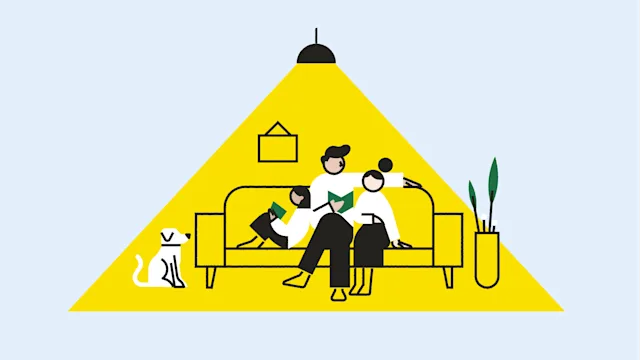Key takeaways:
Hypervigilance causes excessive fear and worry about potential threats or danger. It often stems from an anxiety disorder or from exposure to trauma.
Left untreated, the conditions that cause hypervigilance can take a toll on your mental and physical health.
To learn about treatment for hypervigilance, talk to a mental health professional. They can help you explore therapies that can keep fears and worries at bay.
Do you often feel like you can’t let your guard down and relax? Are you always worried that something bad will happen?
If so, this could be due to something called hypervigilance, which is often brought on by trauma or anxiety. It keeps your brain and body working overtime to keep you safe even when there isn’t a threat at hand.
Fortunately, with the right support, you can learn to relax and feel safe again.
Search and compare options
What is hypervigilance?
Hypervigilance is an overwhelming state of alertness to danger. People living with it are always scanning their environments for threats. But the fear of potential threats is often greater than the true likelihood of danger.
This experience is often associated with post-traumatic stress disorder (PTSD) or an anxiety disorder. It is a response to not being or feeling physically or emotionally safe.
Hypervigilance can leave you always feeling “on guard" and make it hard to relax even when you’re safe. This can:
Deplete your energy
Lower your mood
Make it tough to connect with others
Symptoms of hypervigilance
Hypervigilance can lead to symptoms like:
Difficulty concentrating
Chronic fatigue
Restlessness or feeling “on edge”
Overwhelming feelings of worry
Difficulty falling asleep or staying asleep
Physical aches and pains (that aren’t otherwise explained)
Being easily startled
Angry or aggressive outbursts
Racing heart
Sweating
Loss of interest in previously enjoyed activities
Loneliness or social isolation
Fixating on potential threats
Examples of hypervigilance
No two people experience hypervigilance exactly the same way. But the following are some common examples of how hypervigilance could affect you:
When you walk into a restaurant, you immediately scan the area and identify the exits. You choose a seat close to the door, and you aren’t able to relax during your meal.
Whenever you walk into the office and see people talking, you automatically assume they’re saying something about you. You feel this way even though you’ve never actually heard anyone speaking negatively about you at work.
You used to enjoy trying new things and meeting new people. But these days you would rather just stick to who and what you know because it feels safer that way.
You’re constantly suspicious of your romantic partner and feel tempted to check their phone. You want to know their whereabouts at all times.
Read more like this
Explore these related articles, suggested for readers like you.
What causes hypervigilance?
At its core, hypervigilance is a stress response caused by the mind and body working overtime to ward off a perceived threat and keep us safe. It often arises out of exposure to life-threatening or traumatic events that interrupt the way our brains process information.
For example, many veterans develop PTSD after witnessing horrific events while deployed. Their hypervigilance often manifests when they carry the trauma of the battlefield into civilian life. Rationally they may understand that the threat of warfare is behind them. But their bodies respond as if their life is still in danger.
Hypervigilance can also be a result of having an anxiety disorder. There are four major types of anxiety disorders, including:
Generalized anxiety disorder (GAD)
Obsessive-compulsive disorder (OCD)
Panic disorder
Social anxiety disorder
What health complications might arise from hypervigilance?
Hypervigilance can make you feel like you’re living in a constant “fight or flight state.” Researchers haven’t yet made a direct link between physical health conditions and hypervigilance.
But we do know that trauma or anxiety — of which hypervigilance can be a symptom — may lead to an increased risk of:
Headaches and migraines
Muscle tension
Asthma attacks
Hypertension (high blood pressure)
Heart disease
Heart attack
Stroke
Endocrine problems
Metabolic disorders
Compromised immune function
Gastrointestinal problems
Heartburn
Hormonal imbalances
How does hypervigilance affect relationships?
Hypervigilance, whether due to PTSD or another mental health concern, can impact your relationships. If one person in the relationship is constantly “on guard,” it can be tough for the other person to relax and be themselves. This is even more challenging if the hypervigilance takes the form of suspicion of a partner or constant worries about a partner’s safety.
Sometimes, people experiencing hypervigilancehave trouble regulating their emotions. This can cause conflict and frustration that can also disrupt meaningful relationships.
Remember, if you’re in a relationship with someone with hypervigilance, it’s OK to seek your own support and prioritize self-care.
How can hypervigilance be treated?
To treat hypervigilance, you need to address the underlying causes. For many people, this means seeking help for conditions like PTSD, anxiety, and OCD.
A mental health professional can help you decide the type of support that would work best for you. But here are some of the most effective therapies for conditions that cause hypervigilance.
Eye movement desensitization and reprocessing (EMDR) has you recall past events while practicing left-to-right stimulation, like following a light or pulsing paddles you hold in your hands. This approach allows you to reprocess your thoughts and feelings about past events.
Prolonged exposure (PE) therapy is another option that can help treat PTSD-related symptoms like hypervigilance. In this therapy, you gradually face feared reminders of your trauma. Over time, your fight-or-flight response goes down as you learn the bad outcomes you fear aren’t happening in the present.
Cognitive behavioral therapy (CBT) is the most-researched therapy for anxiety disorders. CBT encourages you to explore how your thoughts, behaviors, and feelings influence each other. Your therapist may also recommend adding exposure therapy as part of your CBT treatment.
Exposure and response prevention (ERP) is used to treat symptoms of OCD. This treatment encourages participants to engage with fear triggers within the safety of therapy. Over time, this can help reduce symptoms of OCD, including hypervigilance.
Depending on your experience, your provider may recommend medication to treat your symptoms. There isn’t a medication for hypervigilance specifically. But medications like antidepressants and anti-anxiety medications can help treat disorders that may include hypervigilance as a symptom.
Mental health resources and support for hypervigilance
If you or someone you care about is struggling with hypervigilance, help is available. To find a mental health professional who can support you, talk to your healthcare provider about a referral.
Or, explore an online directory to find a therapist in your area or one you can meet with online. You can filter your search by:
Location
Gender
Insurance
Specialty
Types of treatment
Look for someone with experience treating trauma, PTSD, anxiety, or OCD.
The bottom line
When working properly, our stress response keeps us safe by letting our bodies and minds know when we need to react to danger. But people dealing with hypervigilance have nearly constant worry, even when there isn’t a threat.
Fortunately, there are treatments that can help you manage your hypervigilance, depending on the cause. With the right support through therapy, you can learn to feel safe, regulate your emotions, and keep your worries in check.

Why trust our experts?



References
American Psychological Association. (2017). What is exposure therapy?
American Psychological Association. (2023). Stress effects on the body.
American Psychological Association Dictionary of Psychology. (n.d.). Hypervigilance.
Campbell, S. B., et al. (2018). Posttraumatic stress disorder and relationship functioning: A comprehensive review and organizational framework. Clinical Psychology Review.
Dykshoorn, K. L. (2013). Trauma-related obsessive–compulsive disorder: A review. Health Psychology and Behavioral Medicine.
Hezel, D. M., et al. (2019). Exposure and response prevention for obsessive-compulsive disorder: A review and new directions. Indian Journal of Psychiatry.
International OCD Foundation. (n.d.). How is OCD treated?
Kang, H., et al. (2017). Impact of anxiety and depression on physical health condition and disability in an elderly Korean population. Psychiatry Investigation.
Kimble, M., et al. (2014). The impact of hypervigilance: Evidence for a forward feedback loop. Journal of Anxiety Disorders.
Kuruna, T. (2016). Understanding how trauma affects health and health care. Center for Health Care Strategies.
Landin-Romero, R., et al. (2018). How does eye movement desensitization and reprocessing therapy work? A systematic review on suggested mechanisms of action. Frontiers in Psychology.
Make the Connection. (n.d.). Feeling on edge. U.S. Department of Veterans Affairs.
National Alliance on Mental Illness. (n.d.). Managing stress.
National Institute of Mental Health. (2020). Post-traumatic stress disorder.
National Institute of Mental Health. (2023). Anxiety disorders.
PTSD: National Center for PTSD. (n.d.). Prolonged exposure (PE) for PTSD. U.S. Department of Veterans Affairs.
PTSD UK. (n.d.). Hypervigilance and PTSD.
Rosen, C., et al. (2013). Presenting concerns of veterans entering treatment for posttraumatic stress disorder. Journal of Traumatic Stress.
Shepherd, L., et al. (2014). Emotion regulation, physiological arousal and PTSD symptoms in trauma-exposed individuals. Journal of Behavior Therapy and Experimental Psychiatry.
Smith, N. A., et al. (2019). Keeping your guard up: Hypervigilance among urban residents affected by community and police violence. Health Affairs.
Watkins, L. E., et al. (2018). Treating PTSD: A review of evidence-based psychotherapy interventions. Frontiers in Behavioral Neuroscience.
Wermes, R., et al. (2018). Anxious and alert? Hypervigilance in social anxiety disorder. Psychiatry Research.
Wiggs, C. L., et al. (1996). Hypervigilance in patients with obsessive-compulsive disorder. Anxiety.
Yoon, S. A., et al. (2016). Salivary biomarkers of neural hypervigilance in trauma-exposed women. Psychoneuroendocrinology.


















